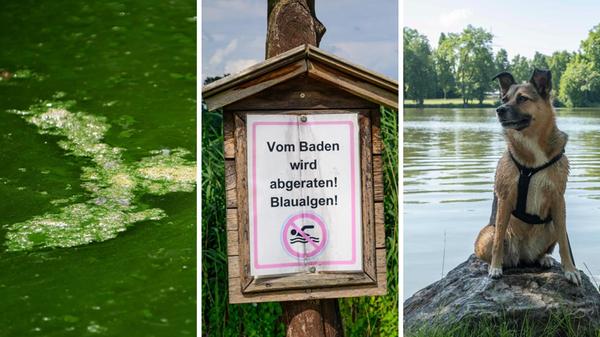
In low concentrations, blue-green algae, which are actually cyanobacteria, are found in lakes, ponds, and rivers. However, when these bacteria multiply excessively and release toxic substances into the water due to increased temperatures and sunlight exposure, they can become highly dangerous for humans and animals. In Franconia, warnings about blue-green algae are on the rise.
Contact with blue-green algae can lead to skin and eye irritations as well as rashes in humans. Ingesting contaminated water may result in vomiting, nausea, and diarrhea. Respiratory problems are also a symptom. The contact can be particularly dangerous for pregnant women, children, individuals with weakened immune systems, people with skin conditions, and animals.
Dogs are significantly more sensitive to blue-green algae than humans. "Every year, dogs die because they have drunk from or swum in contaminated waters," reports the animal rights organization PETA. In France, a jogger possibly died after coming into contact with algae gases.
How to identify blue-green algae?
Jana Hoger, a specialist at PETA, explains how to identify blue-green algae, how poisoning manifests, and what precautions can be taken to avoid adverse effects. "If standing water appears greenish-cloudy or has a slimy green film, animals should neither drink it nor swim in it," says Hoger. "The toxin present in blue-green algae can lead to serious liver damage or liver failure. In the worst case, pets can die from cyanobacteria poisoning." In addition to green streaks or a green-blue layer on the water, smells of ammonia, rotten eggs, and manure are warning signs.
PETA generally advises paying attention to swimming bans and carefully inspecting waters even in the absence of official warnings. To be on the safe side, the animal rights organization also recommends keeping dogs on a leash near bodies of water. After swimming in such waters, pets should be thoroughly rinsed with clear water since blue-green algae can cling to their fur. PETA fundamentally advises dog owners to always carry a bottle of fresh water to offer their pets refreshment and something to drink, especially on hot days, or to clean their fur if necessary.
How do I recognize a blue-green algae poisoning?
Dogs that have been poisoned by blue-green algae exhibit lethargy, weakness, and disorientation. Their mucous membranes may appear pale, with excessive drooling and increased tearing. Additional symptoms can include muscle tremors, rigidity, paralysis, seizures, difficulty breathing, unconsciousness, vomiting, and diarrhea. If poisoning is suspected, it is crucial to visit a veterinarian immediately, as it poses a life-threatening risk.
For humans, high concentrations of cyanobacteria can cause severe mucous membrane irritation, headaches, diarrhea, vomiting, skin rashes, or breathing difficulties. Poisoning from blue-green algae is also highly dangerous for cats, horses, and birds. Once animals are affected, the illness progresses dramatically and is often fatal.
Danger of blue-green algae in the Franconian Lake District
In recent years, the Franconian Lake District has repeatedly struggled with blue-green algae. The focus has primarily been on the Altmühlsee and the Kleine Brombachsee. In the past, swimming bans have been issued for individual lake centers, sometimes lasting several weeks.
The district offices of Roth and Weißenburg-Gunzenhausen both have warning maps on their websites, which allow for monitoring of water quality. At the Altmühlsee, swimming is currently prohibited at the Schlungenhof lake center due to high concentrations of blue-green algae. "Samples are taken at least once a week. As soon as a demonstrable improvement in the situation occurs, the swimming ban will be lifted," stated the county's citizen service. At the other two lake centers, Muhr am See and Seezentrum Wald, swimming is not recommended. Since July 2, there has been a significant increase in blue-green algae at the monitored locations.
A swimming warning has also been issued for the Kleine Brombachsee due to increased concentrations of blue-green algae. A strong proliferation of blue-green algae has been observed since July 14. As of July 15, there are no such warnings or bans for the Große Brombachsee. When a swimming warning is in effect, swimming is still allowed, but caution is advised. Children, pregnant women, and individuals with weakened immune systems are especially advised not to swim.
The signals for the lake centers at the Rothsee and the smaller bathing ponds in the Roth district, such as the Igelsbachsee or the Jägersee, are green and thus deemed suitable for swimming, according to the district office (as of July 15).
Blue-green algae in Franconia 2025
Due to persistent blue-green algae contamination, the Health Department at the Ansbach District Office has urgently recommended a temporary swimming advisory. This affects the "Krummweiher" in the community of Bechhofen. Swimming is prohibited in the natural waters of Nuremberg, except in "Kleiner Dutzendteich" and in the "Badebucht" on the southern shore of Wöhrder See. Using these areas is at one's own risk. Last year, in August, the Service Company for Public Space Nuremberg (SÖR) warned of blue-green algae in "Kleiner Dutzendteich." For 2025, there is currently no such blue-green algae warning.